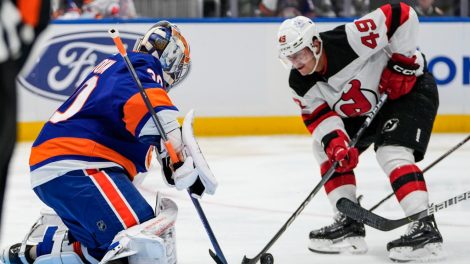There usually aren’t many compelling stories to tell with data from games going on during the NHL’s pre-season. It usually takes into the first couple weeks of the regular season to start to get some idea of how teams are playing and what’s driving those results.
Instead of doing team-specific season previews, an idea that we came up with was to look at specific skill sets league wide, and create a sort of database based on the 2018-19 season that can show us which players most stand out in certain areas.
This is what I attempted to do to isolate Mitch Marner’s playmaking ability last week as a way to determine his value mere hours before he signed long term with the Toronto Maple Leafs.
With that in mind, let’s start along the same track, and look specifically at the best offensive zone passers at 5-on-5 among forwards.
[snippet id=4167285]
In order to begin, we have to figure out what exactly we value most when it comes to passing. Is pass completion rate the most important? What about completed pass volume? What about types of passes — surely the passes that lead to better quality shots are both more important and more difficult to complete?
On top of that, there’s adjusting for team structure. Some teams’ offensive schemes are simply superior and result in higher completion rates than others, so we have to adjust for those. But before we delve too deep, let’s take a general look at every forward from last season who played 750 or more minutes at 5-on-5. All data will be at 5-on-5.
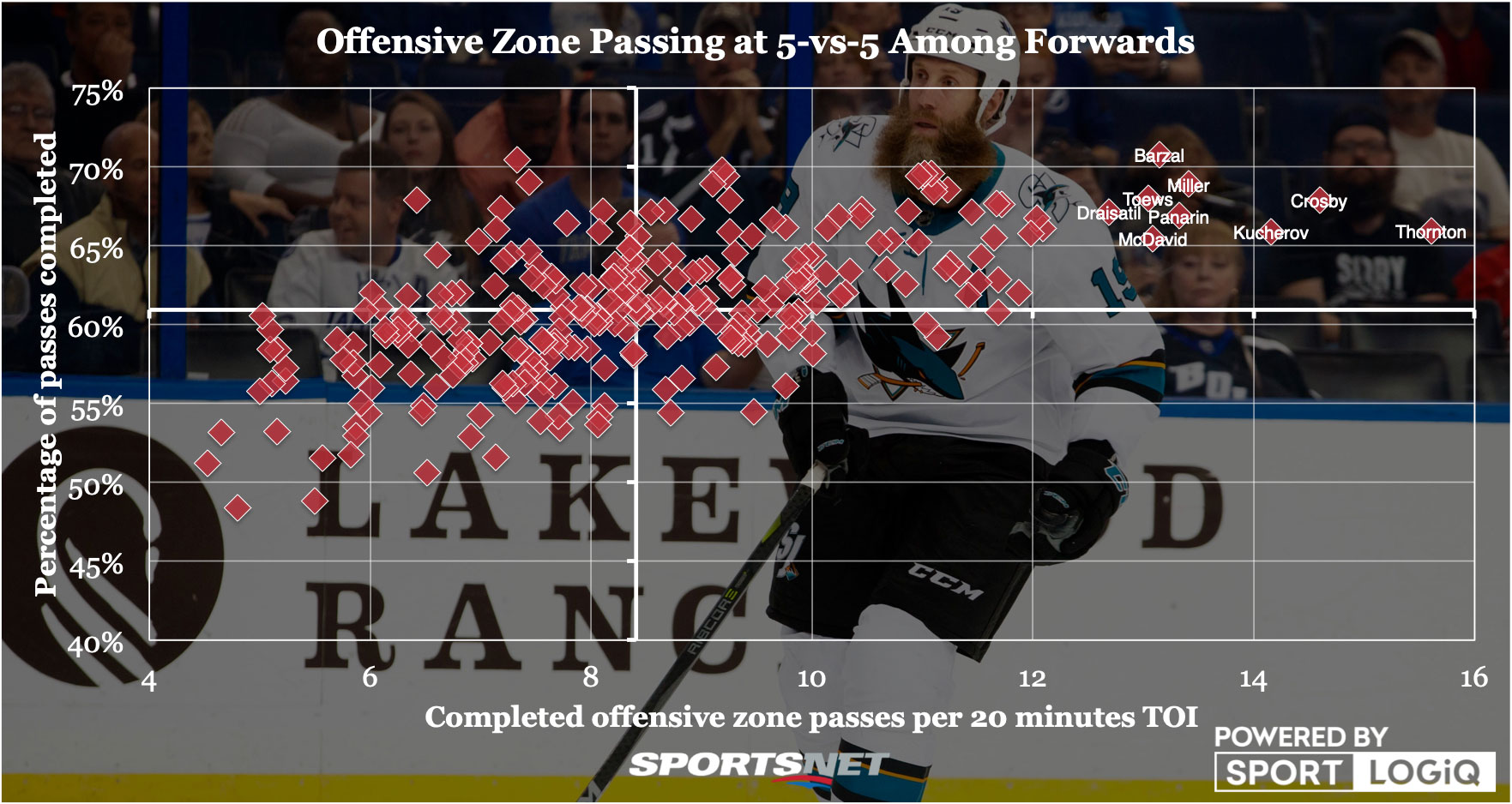
The axis for the graphic have been set to the league averages among forwards, so you can see exactly where players fall compared to their peers. The average NHL forward completes just under 8.41 offensive zone passes every 20 minutes, and completes 60.09 per cent of their pass attempts.
As you may have guessed from the background image, the player way over to the right who completes more offensive zone passes per minute than anyone else in the league is 40-year-old Joe Thornton, the NHL’s active career points leader and assist leader by nearly 300.
The two players closest to him and the only others to complete more than 14 offensive zone passes every 20 minutes of ice time are Sidney Crosby and Nikita Kucherov. So far completed pass volume alone is passing the smell test to isolate the skill.
When looking at completion rates, the best in the league last year wasn’t far behind in volume either, with Mathew Barzal one of only two forwards to complete over 70 per cent of his offensive zone passes, the other being Alex Chiasson, with considerably fewer attempts — less than league average actually.
The next wrinkle is pass types. Instead of looking at how many of each type of pass every player makes, we can use expected completion rates for particular pass types to fold together with the volume each player puts out to create an overall expected pass completion rate based on what each player is doing, so volume of each is accounted for.
Tabulating all that, we’re left with the most accurate passers looking like this.
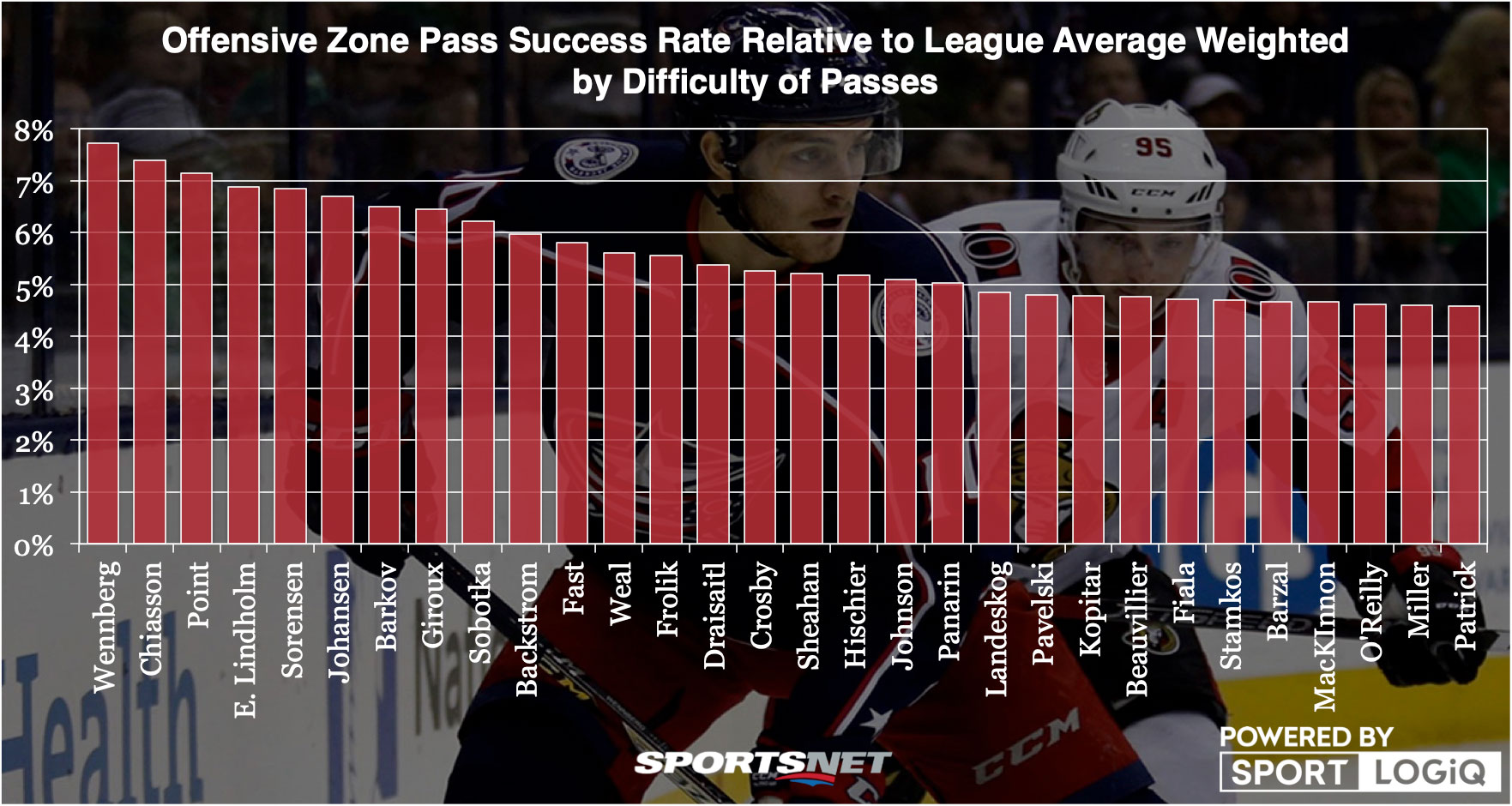
What we have here are the top-30 forwards in the league at completing passes in the offensive zone at a higher rate than expected for forwards, when you adjust for the difficulty of the passes they each make.
With overall pass success rate, theoretically a player could continually make easy passes and post a high success rate. An example would be sending a straight pass up the boards back to the point, which has an expected completion rate of 79.6 per cent and avoid passes to the slot that have an expected completion rate of 35.6 per cent.
What weighting passes has done is remove some of that noise from the equation and reward players who make difficult passes at a higher than average success rate.
The resulting group is interesting, with Alex Wennberg taking the top spot completing passes at a 7.73 per cent higher rate than expected based on the passes he makes. There are lots of high-end playmakers like Brayden Point, Ryan Johansen, Aleksander Barkov, Claude Giroux, Nicklas Backstrom, and Sidney Crosby in there as well, along with some surprises like Chiasson, Marcus Sorensen, Jordan Weal and Riley Sheahan.
[snippet ID=3322139]
Whether those players are budding playmakers or had very good seasons, we do have to add another layer to represent pass success rate in a truly accurate way: team structure.
A great playmaker on a team that struggles to create open lanes can be stifled, so we have to go through each type of pass again and adjust for how each players’ teammates manage to complete passes without them, creating a pass success rate that adjusts for difficulty of passes and system driven results.
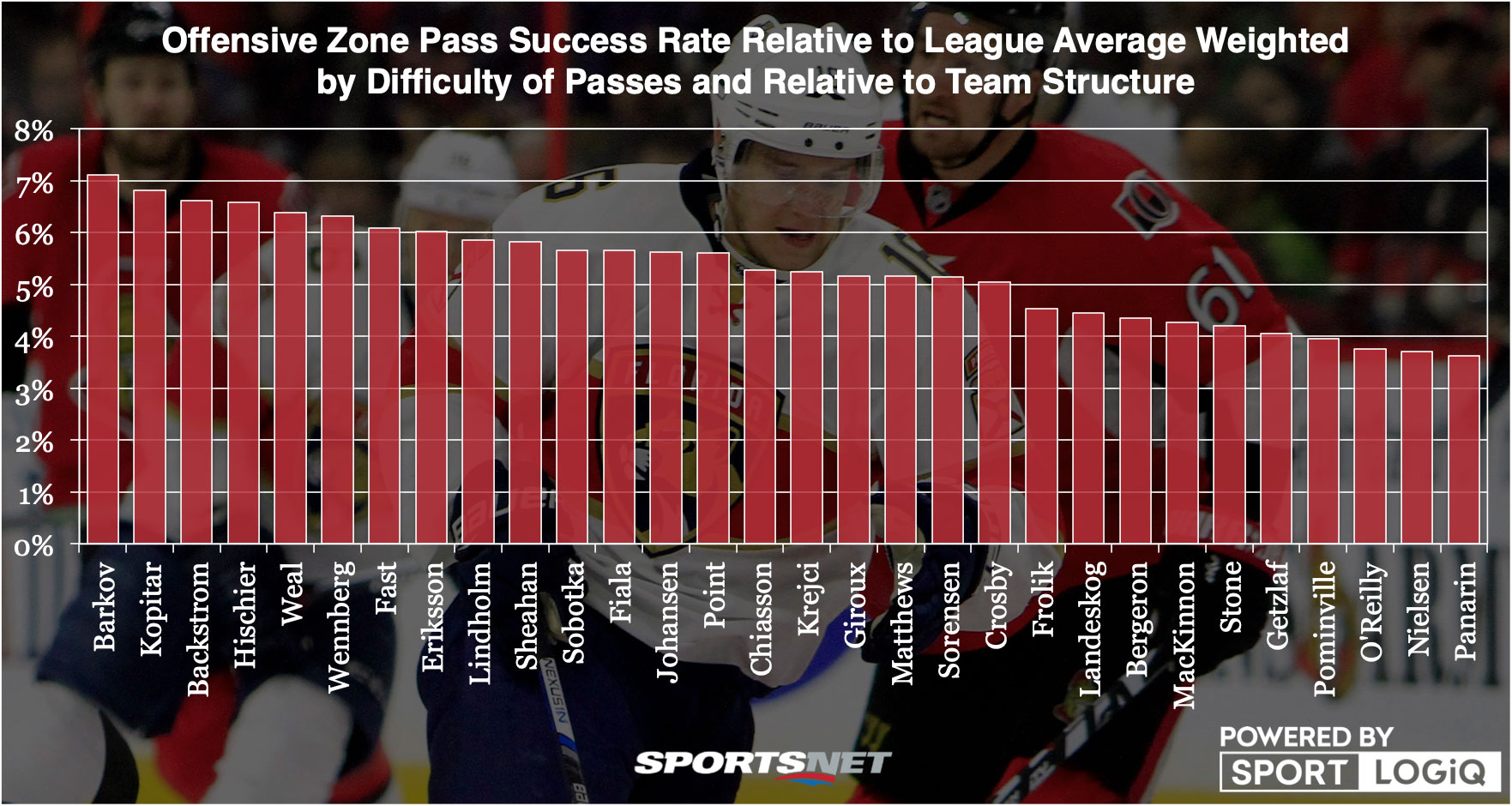
Post-adjustment, the top of the list looks a lot more familiar, as any statistic that measures success rates or precision in play seems to have Barkov somewhere near the top. Kopitar has posted the best overall pass success rate in all three zone relative to teammates for three straight seasons, so he makes lots of sense too.
There are still some surprising names in there, especially a guy like Jordan Weal way up in the top five, or Vladimir Sobotka in there after having a terrible season. But overall the players in here make sense, especially if we remember that this is all about pass accuracy, even if we’re weighting by pass type.
Being an accurate passer still doesn’t automatically mean they’re making the most impact, so knowing what we do about pass accuracy, let’s take these same players and look at the actual volume of passes they’re completing and what types of passes, before we decide who the best are.
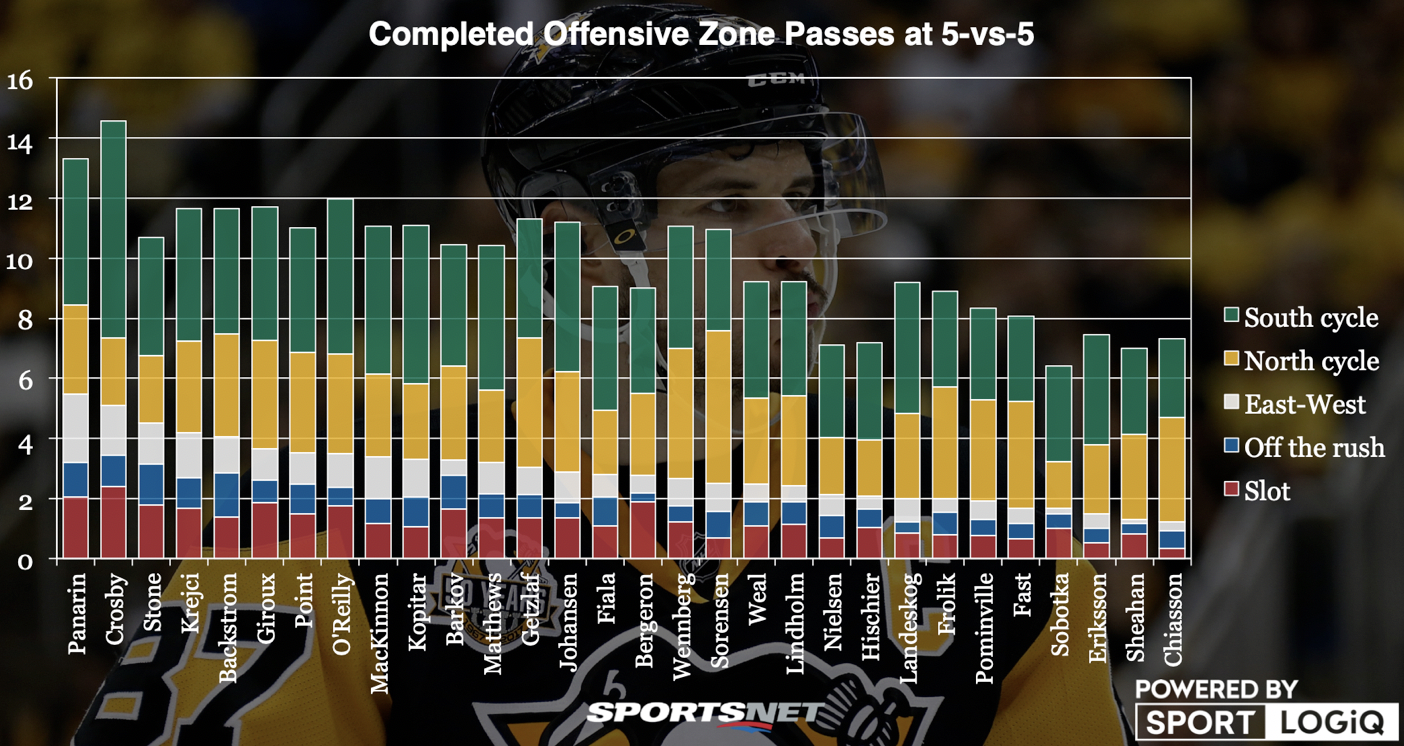
When we factor in volume and prioritize the types of passes by the ones that create the most scoring plays — passes to the slot, followed by passes off the rush, followed by East-West passes — we can see that there are a large number of players on the ‘most accurate’ list that are there because they don’t accomplish much.
The most confusing players on the list like Chiasson, Sheahan, Eriksson, and Sobotka all rarely make plays that require a lot of skill and create scoring chances — they mostly either cycle the puck, or send it up to the point to reset. I don’t want to say that’s useless, but it doesn’t accomplish as much as the high-skill plays do.
[snippet id=3816507]
Ordered by dangerous passes, we can see clearly that two players stand out above the rest by a significant margin: Crosby and Panarin. The group behind them is excellent as well, with Mark Stone, the perennially underrated David Krejci, Backstrom, and more, but the level at which Crosby and Panarin stand apart is impressive.
So who is better between them? Crosby completes more passes overall, Panarin completes more dangerous passes overall, but Crosby completes more slot passes.
The tiebreaker comes back to accuracy. While Panarin completes his passes at a rate 3.63 per cent better than expectations for a league average forward, Crosby is at 5.05 per cent, so Sid the Adult still reigns supreme in the league as a passer.
[relatedlinks]






